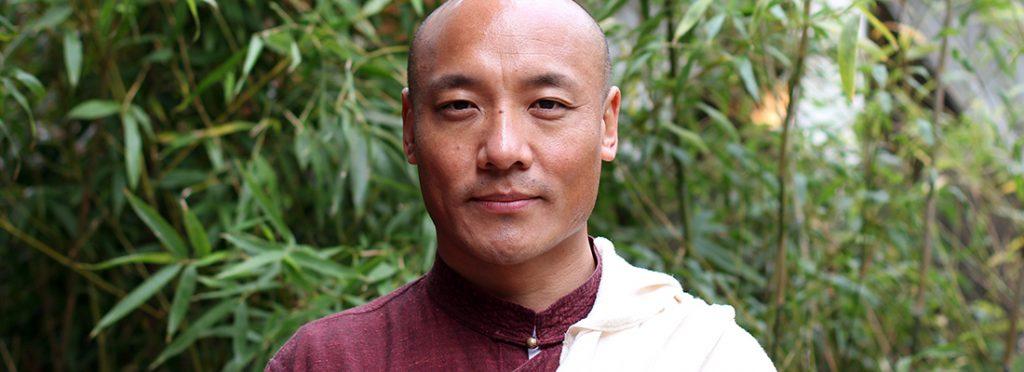By Anam Thubten Rinpoche
June 17, 2022

Ahimsa (Skt: nonviolence), is the central observance of the Buddhist tradition and belongs to the practices of sila (Skt: ethics), which is one of the three trainings of the Noble Eightfold Path, along with wisdom and meditation. When someone embarks on the Buddhist path, she or he takes a vow to refrain from harming others until the moment of death. The sutras offer specific definitions of ahimsa, such as refraining from taking the life of other beings, including animals. In many Buddhist cultures, the popular understanding of ahimsa is mainly associated with refraining from taking life from others, the first of the five precepts of being a Buddhist. There are specific occasions when adherents observe these precepts with a great deal of care, especially during holy days based on the Buddha’s life.
But in essence, ahimsa means not causing harm to others. As the world around us is continually changing, the definition of ahimsa should be interpreted in a way that meets the spiritual needs of modern people.
First, let’s realize that the world has entered a new era—what we might like to call the “era of conscientiousness.” With rapid technological advances, all forms of information are becoming more available than ever before—news from one side of the world can travel to the other side in seconds; people are more informed about everything than their parents’ generation; and so forth. Climate change, war, violence, inequality, injustice, all these issues from around the world are talked about in conversation at the dinner table, on various online platforms, and in national and regional news. Perhaps many people in Japan care about the civil war in Syria, whereas a few centuries ago, the general population of Japan may have had no geographical knowledge about that part of the Middle East. South Koreans are aware of the hardships of people in Africa, who are suffering from food shortages. Americans are deeply concerned about ethnic conflict in Myanmar, yet only a few centuries ago, Americans had nothing to do with that country. Not only that, slavery would have been a legitimate, widespread system in US. Since then, the world has come long way. It can be a stunning matter to compare past circumstances with the present.
This new level of conscientiousness should be welcomed, even though it might sometimes not give us easy solace. There is also resistance from people who feel comfortable thinking in terms of old social and economic structures that have served them quite well. It’s like spoiling the party. Yet the old party is enjoyed by very few and might not be sustainable. It is better to wake up and to be part of this global awakening.
The biggest challenges facing us now are pathological inequality and environmental degradation. Unless these issues are addressed, and unless we take action to change them, humanity is going to face endless problems and suffering for centuries to come. These two problems are not easing but are being continually exacerbated. Let’s talk about the impact that these problems are having in the world.
Inequality is not only an issue in so-called third-world countries. It is a major global problem and an impediment to the healthy economic growth of entire nations. Inequality causes calamity for its victims, including health and mental issues, and depriving them of their basic human dignity. Data on inequity around the world can shock us so much that we might feel that there is something wrong with the whole system. This inequality has many shades. In extreme situations, it breeds poverty, which becomes the cause of numerous problems, such as modern slavery. The practice of slavery has been pretty much abolished in the constitutions of almost all nations. Yet a highly concealed institution of slavery continues to exist in different forms that are not easily seen, unless a thorough analysis is performed. Some of these analyses show that there are more slaves now than any time in human history.
What will the world look like a few decades from now? This is a question that makes many people nervous. Yet even if it comes with discomfort, the question should be asked again and again. Our children might not inherit a planet where they can enjoy a good life. Of course, no one has a crystal ball to perfectly predict the course of the future. But we do know that if current ecological trends continue, there will be extreme weather, droughts, floods, fire, and massive relocation on a global scale, which will also result in political chaos. The main factor behind all of these is environmental degradation. Instead of some kind of unexpected periodic occurrence in the natural world, such as the Ice Age, or the comet that wiped out dinosaurs, environmental degradation is directly related to anthropogenic activities. There is mounting scientific evidence to prove this.
Ahimsa is a practice that intentionally stops any activities that can cause harm to living beings and also to the natural world. It begins with conscientiousness; otherwise, ahimsa will remain purely an incomplete theory. In the beginning, responsible individuals can practice this holistic ahimsa. Eventually, the whole of society must embrace it—religious and secular people alike. Ahimsa doesn’t come with a religious badge. You can be a Buddhist or non-Buddhist and practice ahimsa in everyday life for the benefit of the whole world. Indeed, many secular people are embodying ahimsa in their lives, protecting the environment and working for good causes. With all of the heartbreaking problems in the world, our world is also blessed by all these goodhearted people.
Therefore, there is hope.
It is like a beacon shining in the darkness. It will grow brighter and brighter.
See more
Dharmata Foundation
Related features from BDG
Buddhistdoor View: On the Moral and Traditional Complexities of Abortion
Manifesting Avalokiteshvara: The Jewel within the Lotus
A Metta Prayer
More from Dharma Gossip by Anam Thubten Rinpoche
Tags: ahimsa, Anam Thubten Rinpoche, awakening, buddhism, buddhist path, conscientiousness, digital technology, environmental crisis, environmental degradation, environmental ethics, equality, ethics, hope, inequality, Noble Eightfold Path, nonviolence, sila, slavery, social change, Tibetan Buddhism, vajrayana

Anam Thubten Rinpoche grew up in Tibet and at an early age began to practice in the Nyingma tradition of Tibetan Buddhism. Among his many teachers, his most formative guides were Lama Tsurlo, Khenpo Chopel, and Lama Garwang. He is the founder and spiritual advisor of the Dharmata Foundation, teaching widely in the US and internationally. He is also the author of various articles and books in both the Tibetan and English languages. His books in English include The Magic of Awareness and No Self, No Problem. Through the essential wisdom of Buddhism and his personal experience on the spiritual path, Anam Thubten brings alive the timeless teachings and invites everyone to participate. More infomation can be found at: www.dharmata.org Dharma Gossip is published bi-monthly
No comments:
Post a Comment